7B-Unit3-Welcome-to-Sunshine-Town-教案
牛津译林版英语七下Unit 3《Welcome to Sunshine Town》教学设计6
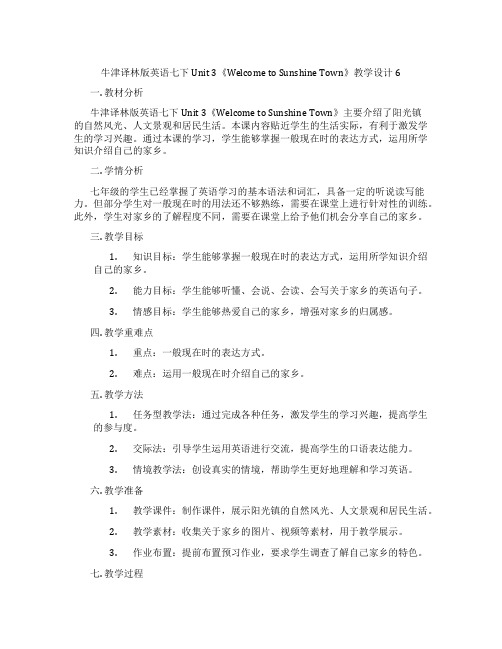
牛津译林版英语七下Unit 3《Welcome to Sunshine Town》教学设计6一. 教材分析牛津译林版英语七下Unit 3《Welcome to Sunshine Town》主要介绍了阳光镇的自然风光、人文景观和居民生活。
本课内容贴近学生的生活实际,有利于激发学生的学习兴趣。
通过本课的学习,学生能够掌握一般现在时的表达方式,运用所学知识介绍自己的家乡。
二. 学情分析七年级的学生已经掌握了英语学习的基本语法和词汇,具备一定的听说读写能力。
但部分学生对一般现在时的用法还不够熟练,需要在课堂上进行针对性的训练。
此外,学生对家乡的了解程度不同,需要在课堂上给予他们机会分享自己的家乡。
三. 教学目标1.知识目标:学生能够掌握一般现在时的表达方式,运用所学知识介绍自己的家乡。
2.能力目标:学生能够听懂、会说、会读、会写关于家乡的英语句子。
3.情感目标:学生能够热爱自己的家乡,增强对家乡的归属感。
四. 教学重难点1.重点:一般现在时的表达方式。
2.难点:运用一般现在时介绍自己的家乡。
五. 教学方法1.任务型教学法:通过完成各种任务,激发学生的学习兴趣,提高学生的参与度。
2.交际法:引导学生运用英语进行交流,提高学生的口语表达能力。
3.情境教学法:创设真实的情境,帮助学生更好地理解和学习英语。
六. 教学准备1.教学课件:制作课件,展示阳光镇的自然风光、人文景观和居民生活。
2.教学素材:收集关于家乡的图片、视频等素材,用于教学展示。
3.作业布置:提前布置预习作业,要求学生调查了解自己家乡的特色。
七. 教学过程1.导入(5分钟)教师通过展示阳光镇的自然风光、人文景观和居民生活的图片,引导学生谈论并对阳光镇产生兴趣。
2.呈现(10分钟)教师展示关于家乡的图片、视频等素材,引导学生用英语进行描述。
同时,教师引导学生用一般现在时表达家乡的特点。
3.操练(15分钟)教师学生进行小组活动,要求学生用英语介绍自己的家乡。
7B_Unit3_Welcome_to_Sunshine_Town_教案设计

5) You can choose any food you like in Sunshine Town.
6) Why don’t you visit our local theatre with us?
2. Write sth. about the students’home town life with these words and phrases.
2. To master some sentences.
1)There’s less are pollution in Sunshine Town than in other areas of Beijing.
2)You can choose any food you like in Sunshine Town.
4)Would you like to enjoy Beijing Opera?
5)Would you like to go shopping in Sunshine Town?
Step Two Entering
OK. Today I’ll take you to Sunshine Town for a trip. Sunshine Town is a great new Town. There are lots of things to do there. There’s less air pollution than in other areas of Beijing. There are many tall buildings and you can go any by underground. There are lots of lakes and trees in the country park. There are lots of lakes and trees in the country park. There are lots of lakes and trees in the country park. There ate also many theatres here. You can enjoy Beijing Opera.
牛津译林版七年级下册(新)英语教案7BUnit3WelcometoSunshineTownReading1

情感目标 3. To learn to describe the city and the lifestyles.
教学重点 Know something about the activities in community.
教学难点 Help them use the knowledge to say something about the activities.
Review the names of the things Teach new vocabularies. Consolidate the new learning vocabularies by guessing game. Step7Extension Learn new vocabularies. Read text quickly, and do the exercises Read the whole text, finish exercises Step7Extension Students can learn better by listening to the script. Reading fast can develop the right reading habits. Understanding of different types of read the questions to help students complete the curricular and articles. The free communication is the stage of reading the text, the integrated use of the knowledge. Enable students to appreciate the power of collective intelligence cooperation, complementarity and common progress. Consolidate the knowledge. Put forward their own views. Step8Homework Show some pictures to review the words . Have a guess according to the description of the teacher.
牛津译林版英语七下Unit 3《Welcome to Sunshine Town》教学设计1

牛津译林版英语七下Unit 3《Welcome to Sunshine Town》教学设计1一. 教材分析《Welcome to Sunshine Town》是牛津译林版英语七年级下册Unit 3的主题课文。
本节课文主要介绍了一个名叫Sunshine Town的地方,通过描述那里的风景、设施和人们的生活,让学生了解到一个和谐、美好的社区。
课文内容丰富,语言简练,插图生动,易于学生理解。
本节课的教学内容与学生的日常生活紧密相连,有利于激发学生的学习兴趣和参与度。
二. 学情分析七年级的学生已经具备了一定的英语基础,能够进行简单的英语交流。
但部分学生对英语的学习兴趣不足,主动性有待提高。
此外,学生对社区的认知有限,需要通过本节课的学习,拓展他们对社区的认知。
三. 教学目标1.知识目标:学生能够掌握课文中的关键词汇和句型,理解课文内容。
2.能力目标:学生能够用英语描述一个地方的特点和设施,进行简单的交流。
3.情感目标:学生能够认识到社区的重要性,培养热爱社区、关心他人的情感。
四. 教学重难点1.重点:课文的理解和词汇的掌握。
2.难点:运用英语描述一个地方的特点和设施。
五. 教学方法1.情境教学法:通过创设情境,让学生在实际环境中运用英语。
2.互动式教学法:引导学生积极参与课堂活动,提高他们的英语实践能力。
3.任务型教学法:通过完成任务,让学生在实践中学习英语。
六. 教学准备1.课文录音:为学生提供听力材料,提高他们的听力能力。
2.教学图片:用于展示Sunshine Town的风景和设施。
3.任务单:用于引导学生进行课堂活动。
七. 教学过程1.导入(5分钟)教师播放课文录音,让学生初步感知课文内容。
然后提问:“你们对Sunshine Town有什么了解?”引导学生发表自己的看法。
2.呈现(10分钟)教师展示Sunshine Town的风景和设施的图片,引导学生用英语描述。
同时,教师板书关键词汇和句型,如“There is a river in SunshineTown.”“The people in Sunshine Town are friendly.”等。
7B Unit3 Welcome to Sunshine Town Reading 2 教案

2.To retell the text in your own words.
教师活动内容、方式
学生活动内容、
方式
旁注
Step1Revision
1. First ask student:How well do you know Sunshine town?
Complete the profile.
教后记:
Students finish the exercises carefully in class
Finish filling the blanks according to the passages, read the passages together aloud.
Retell the texts by looking at the information given
Revise the text and get ready to retell the text
Students use own language to retell the texts.
Step 6 Homework
Consolidate and collect the knowledge. Put forward their own doubts.
Finish all the homework carefully
Review the contents learned in the last class.
Train students’ different abilities
Step 5Consolidation
Consolidate the new learning vocabularies and phrases by practicing.
初中七年级英语7B Unit3 Welcome to Sunshine Town全部教案

7B Unit3 Welcome toSunshine TownComic StripTeaching aims and demands:1.Make suggestions about visiting places and doing activitiese.g.Let`s go swimming.e “Howmuch”and“Ho w many”,“no”and“none”toe xpressquantities.Warm-up activities1.AskSstoreadComicStrip.Andaskmyquestion“HowmuchmoneydoesEddiehave?”2.Read the dialogue again ,then ask them to act it out .3. Language points(1).There is no dog food, Eddie!No=not anye.g. I have no coats like this .=I don’t(2).How many tins of dog food can we buy with that?e.g. We write with pens.Welcome to the unitTeaching aims and demands:New words: badmintonTeaching aims:1.To revise vocabulary about activities and places in new situations2.To make suggestions about visiting different placesTeaching procedures:1.Ask Ss to do Part A and B on their own using the information provided in the pictures prompts2.Ask Ss about what they can do in their local areas. Then ask them towrite four sentences about what they like and could do in their areas.Postscript: The students are interested in the four pictures and they can know the meanings.All the students can grasp the lesson.ReadingTeaching aims and demands:Newwords: underground, air, pollution, area, country, lake, building, such, place, like, close, far, h ey, until, souvenir, so, western, local, theatre, teach, dirty, take, lessTeaching methods: task-based approachTeaching task: 1. To read and learn about something about Sunshine Town..2. To grasp the main idea of each paragraph..3. Ask Ss to write an article to introduce their own home town, using the context as a model. Teaching aids: tape recorder, picturesTeaching procedures:1.Ask some students some questions “Are there any tall buildings in your home town?” “What can you do in your town?”, etc..2.Presentation (1).Use the pictures to teach the new words.(2) Now let’s listen to the tape and say “T” ore whole class.① It takes 40 minutes to walk to the center of Beijing from Sunshine Town.②There is less air pollution in Sunshine Town.③ Many students live in tall buildings.④ There are only two shopping malls in Sunshine Town.⑤You can eat Beijing Duck in Sunshine Town.⑥ You can enjoy Beijing Opera at the theatre.(4)Language points:①= It takes 40 minutes to go to Sunshine Town from the center of Beijing by underground. ② There is less air pollution in Sunshine Town than in other areas of Beijing.Less…than…→more…than…e.g. There is less water in this glass than in that one.I have more books than he.③ Here is such a tall building. such+a/an+adj.+n.(single)e.g. such a beautiful gardensuch an interesting story④ be close to =be n ear→ be far from⑤ We do not have to go far if we want help with our homeworkIf……+clause……,……clause…… 如果……,……⑥You can choose any food you like in Sunshine Town.Any:任何 you like 修饰前面的food⑦ If so, you are in the right place.so 这样,指前面一句的意思If so=If you would like to eat Chinese food.e.g. Tom is a good boy. Do you think so?⑧ Why don’t you visit our local theater with us?Why don’t you do=Why not doe.g. Why don’t you go swimming?Why not come with me?(5) Sum-upGo through the new words and language points.HomeworkFinish the Ex of Page24 and 25.Postscript: The reading is related to the reality so the students are interested in the reading and they can know the meanings.All the students can grasp the lesson.7B Unit3GrammarTeaching aims and demands:New words: waiter, shopper, cashier, sick, hospital, ham, clip, beef, fork, plate, each, loaf, packet, carton, Coke, either, right, thirsty, finger, hold, week, group, exchangeTeaching methods: task-based approachTeaching task:1.To develop an understanding of names of occupations and names of related places2.To use names of places to describe their functions3.To use “How much” and “How many” to talk about quantities.4.To use “no” and “none” in the context of quantity.5. To recognize and use the definite article.Teaching aids: tape recorderTeaching procedures:Ⅰ. Warm-upAsk the Ss to talk about what their parents/uncles……doⅡ. V ocabulary1. Revise the names of occupations and names of related places.2. Learn new vocabulary and spellingwaiter cook teacher student doctor nurse shopper cashierrestaurant school hospital supermarketⅢ.Grammar1. Revise the key vocabulary about food itemsAsk Ss to identify countable and uncountable nouns of food.2 .Complete the sentencesHow many +countable nouns(pl.)How much + uncountable nounse.g. How many apples do you need?How many eggs do you have?How much Coke do you need?3. Complete the conversation with “no” or “none”(1) no =not any no +noun.e.g. She has no friends.No ones knows.There is no water in the glass at all.(2) none prep. 没有人或没有东西e.g. None of them are listening to you.Is there any time left? No, none at all.4. The article “a”,“an”,“the”(1)表示某人(事物)某一种类 My father is a driver.Do you like an apple or a pear?(2)表示某一事物中的任何一个 An elephant is bigger than a horseA monkey can climb trees.(3)表示某人某物,但不具体说明何人何物 A student from Class Two runs fastest.A man is calling now.(4)表示数量有”一”的含义 There is a book on the desk.A panda has a mouth, a nose and two eggs.(5)用于固定词组 half an hour, a lot of, have a rest, a moment ago(6)上文提过,下文重复 I have a new pen. The pen is a present from my dad.(7)世界上独一无二的事物 the sun, the moon(8)序数词前,表示方位的名词前,形容词最高级前 the first, in the south, the best(9)乐器名词前 play the piano(10)在复数姓氏前the Browns(=the Brown family) are going to Shanghai for a holiday.(11)一些形容词前表示一类人 the rich, the old(12)专有名词和习惯用语中the Great Wall, by the way, in the morning(13)不用冠词的情况①节目,星期.月份,季节,年,学科前 in summer, in August, on Sunday②一些专有名词,不可名词,称呼和头衔前 China, Grade Two, Mr. Li, Dr. Liu③表示颜色,语种和国家前 in purple, Japanese, England④一些短语中 have breakfast, play footballⅣ. Discussion (task)Have a discussion and find out the use of the article.Ⅴ.Homework1. Review the contents of this lesson.2. Do the Ex of the workbook.Postscript :Fromthelesson,theycan develop an understanding of names of occupations and names of related places , use names of places to describe their functions , use “How much” a nd “How many” to talk about quantities, and they can use “no” and “none” in the context of quantity.Integrated skills and Study skillsIntegrated skillsTeaching aims and demands:1. To listen for detail and abstract information about making arrangements.2. To order information from a tour guide’s introduction.Teaching procedures:Ⅰ. Bring some pictures about famous local places to class. Ask a few very general questions. “Do you like the place?”“Have you visited there?”.Ⅱ. Go through some key vocabulary items in PartA1&A2: exhibitions, golden thrones, pottery Ⅲ. Tell Ss to fill in the table in PartA2 carefully, then check the answers.Ⅳ. NotesBaohe Palace---works of art这里的works作可数名词,是“作品”,“著作”的意思,而work作为不可数名词是“工作”之意.e.gAt last I found work in the city.Ⅴem to do the task on their own first, then check answers.Ⅵ. Ask Ss to read Simon’s notes in PartA4. Play the recording again and ask Ss to complete PartA 4. Check answers as a class.Part BⅠ. Read after the tape.Ⅱ.Two Ss in a pair and role-play the conversationⅢ.Ask Ss to make a new dialogue. Using the dialogue in Part B as a model.Ⅳ.Talk to Ss about making arrangements.e.g. visiting friends, going to cinema, going to a restaurant.PronunciationⅠ.Teaching aimsTo recognize the number of syllables in a word from listening and reading.Ⅱ.Teaching the new material1. Talk to Ss about the sound and intonation of English.2. Say a few simple words which Ss know well. Ask Ss how many beats they can hear.girl, boy, dog, hometea.cher, bro.ther, sis.ter, stu.dent,to.mor.row, yes.ter.day, cin.e.ma3. Go through the examples in Part A4. Listen to the tape and write the number of syllables they hear for the words in Part B.5. Check answers.6. Ask Ss to do the puzzle in Part C.7. Play the recording for Part D. After checking the answers, ask more able Ss to write the numb er of syllables they hearPostscript :listen for detail and abstract information about making arrangements.and order information from a tour guide’s introduction. They did a good job.TaskTeaching aims and demands:Teaching methods: task-based approachTeaching task:1. To become familiar with a new text-script.2. To organize language and descriptions to achieve interest.3. To read a video script to the class.4. To assess recognition of things we can find in a town.Teaching procedures:Ⅰ. Warm-upAsk the student to have a free talk.Ⅱ. Main task (Part A)1. Talk to Ss about the purpose of writing a video script. It is important to engage students’ inter est at this stage as free writing takes a lot of courage.2. Encourage them to bring in pictures, and make sketches and drawings to go with their texts.3. Tell Ss that they need to organize pictures and text. They can use the planning notes on Page 35 as a guide.4. Go through the notes under “Town” and ask Ss to choose 2 or 3 items.5. Ask Ss to describe some items on the “things to do” list, e.g. where they can do things and ho w they feel about it.6. Ask Ss to write about their home town. Ask Ss to focus on writing for a specific audience, the British exchange Ss.7. Then ask Ss to work on their own to number the items in the order of how much they like eac h item. Next, ask them to write down on the right side of the paper some reasons.Ⅲ. Main task (Part B)1. Ask Ss to work in pairs. Have them read Jo hn’s video script in Part B1 and discuss his home t3. Ss rewrite their video scripts on a separate sheet of paper and add illustrations.Ⅳ. Checkout (Part A)ite on the Bb. 2.r them to have a general understanding of text and the context.3. Set a time limit. To encourage Ss to read the conversation before writing.4. Check the answers.Ⅴ. Checkout (Part B)1. Tell Ss about word-search puzzles if they are unfamiliar with them.2. Set a time limit of 5~10 minutes.3. Ask more able Ss to make a word snake of their ownPostscript :Fromthelesson,theycanbecome familiar with a new text-script. , organize language and description s to achieve interest.and they can To assess recognition of things we can find in a town.7B Unit 3 练习题一、根据句意及所给首字母或中英文提示,完成下列句子。
牛津译林七下Unit 3 Welcome to Sunshine Town Task 教案
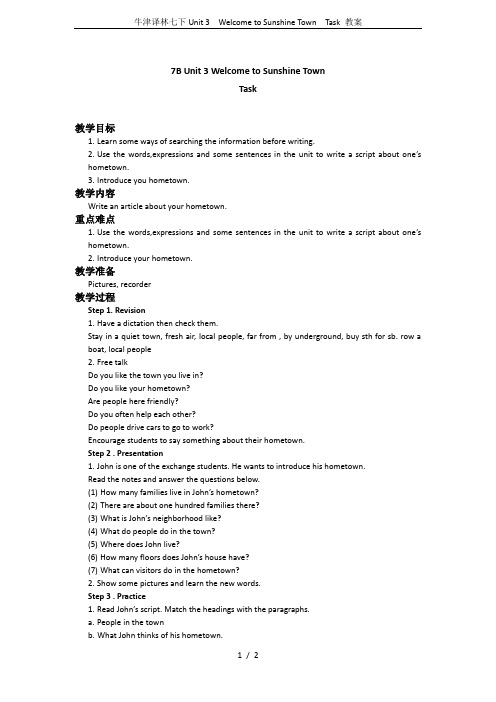
7B Unit 3 Welcome to Sunshine TownTask教学目标1.Learn some ways of searching the information before writing.e the words,expressions and some sentences in the unit to write a script about one’shometown.3.Introduce you hometown.教学内容Write an article about your hometown.重点难点e the words,expressions and some sentences in the unit to write a script about one’shometown.2.Introduce your hometown.教学准备Pictures, recorder教学过程Step 1. Revision1.Have a dictation then check them.Stay in a quiet town, fresh air, local people, far from , by underground, buy sth for sb. row a boat, local people2.Free talkDo you like the town you live in?Do you like your hometown?Are people here friendly?Do you often help each other?Do people drive cars to go to work?Encourage students to say something about their hometown.Step 2 . Presentation1.John is one of the exchange students. He wants to introduce his hometown.Read the notes and answer the questions below.(1)How many families live in John’s hometown?(2)There are about one hundred families there?(3)What is John’s neighborhood like?(4)What do people do in the town?(5)Where does John live?(6)How many floors does John’s house have?(7)What can visitors do in the hometown?2.Show some pictures and learn the new words.Step 3 . Practice1.Read John’s script. Match the headings with the paragraphs.a.People in the townb.What John thinks of his hometown.c.John’s housed.The way to the town centere.GreetingsParagraph 1 : (e)Paragraph 2: (c )Paragraph 3.:(a & d )Paragraph 4:( h )2.Pay attention to the intonation. Listen and read the text.3.Find some useful expressions in the script. You can also learn from John’s article.Step 4. WritingWhose hometown is better, yours or John’s? now please write an article about your own hometown. What should you write in your article ? please make your own notes . ask students to use John’s notes in Part A as a model. It’ll help you write your own article late.Discuss in groupIt’s your turn now to write an article to introduce your hometown. Please work in groups of four and use the idea s you got just now.Ask the students to read their articles. Choose some students to introduce their hometown in class.Step 5 . Homework1.Write an article about your hometown .2.Recite the article about John’s hometown .3.Remember the words and expressions i Unit 3.板书设计。
牛津译林版英语七下Unit 3《Welcome to Sunshine Town》教学设计5
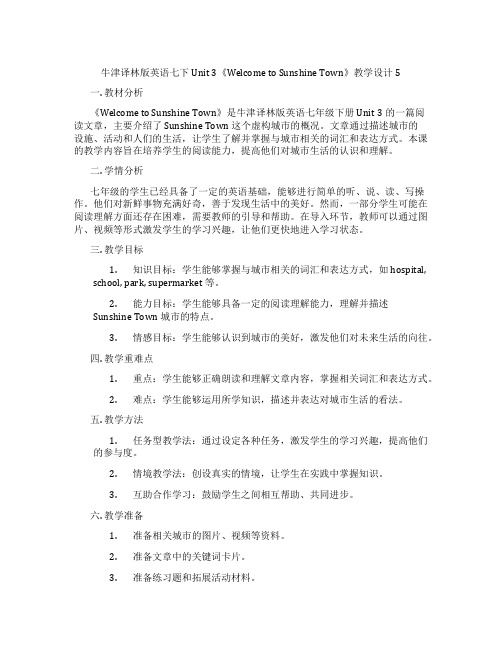
牛津译林版英语七下Unit 3《Welcome to Sunshine Town》教学设计5一. 教材分析《Welcome to Sunshine Town》是牛津译林版英语七年级下册Unit 3的一篇阅读文章,主要介绍了 Sunshine Town 这个虚构城市的概况。
文章通过描述城市的设施、活动和人们的生活,让学生了解并掌握与城市相关的词汇和表达方式。
本课的教学内容旨在培养学生的阅读能力,提高他们对城市生活的认识和理解。
二. 学情分析七年级的学生已经具备了一定的英语基础,能够进行简单的听、说、读、写操作。
他们对新鲜事物充满好奇,善于发现生活中的美好。
然而,一部分学生可能在阅读理解方面还存在困难,需要教师的引导和帮助。
在导入环节,教师可以通过图片、视频等形式激发学生的学习兴趣,让他们更快地进入学习状态。
三. 教学目标1.知识目标:学生能够掌握与城市相关的词汇和表达方式,如 hospital,school, park, supermarket 等。
2.能力目标:学生能够具备一定的阅读理解能力,理解并描述Sunshine Town 城市的特点。
3.情感目标:学生能够认识到城市的美好,激发他们对未来生活的向往。
四. 教学重难点1.重点:学生能够正确朗读和理解文章内容,掌握相关词汇和表达方式。
2.难点:学生能够运用所学知识,描述并表达对城市生活的看法。
五. 教学方法1.任务型教学法:通过设定各种任务,激发学生的学习兴趣,提高他们的参与度。
2.情境教学法:创设真实的情境,让学生在实践中掌握知识。
3.互助合作学习:鼓励学生之间相互帮助、共同进步。
六. 教学准备1.准备相关城市的图片、视频等资料。
2.准备文章中的关键词卡片。
3.准备练习题和拓展活动材料。
七. 教学过程1.导入(5分钟)利用图片、视频等形式展示不同城市的景观,引导学生谈论自己对城市的印象。
教师提出问题,如:“What do you like about cities?”,让学生发表自己的看法。
牛津译林版七年级英语下册《Unit 3 Welcome to Sunshine Town Task》

《Unit 3 Welcome to Sunshine Town Task》教案年级七年级科目英语课题7B Unit 3 Welcometo Sunshine TownTask课时 1 课型new 授课时间教学目标To get to learn more words ,phrases and sentences To try to write your hometown重点hear do sth/some…, and others…/raise cows/grow wheat难点hear do sth/some…, and others…/raise cows/grow wheat教学准备Multim edia;教学设计详案二次备课内容S tep 1 Presenta tionT: John is one of the exchange students. He wants to introduce hishometown. Please read his notes and answer the questions:⑴How many families live in John’s hometown?⑵How do people get to the town centre?⑶What is John’s neighbourhood like?⑷What do people do in the town?⑸Where does John live?⑹How many floors does John’s house have?⑺What c an visitors do in John’s hometown?Step 2 Activ ity ----- Making sentences with the phrases1. T: Now, please work in groups and put the phrases in John’snotes into sentences and then intro duce John’s hometown simply.2. Ask volu nteers to present his/her introduction.Step 3 Reading1. Read after the tape.2. Students read J ohn’s article together.Step 4 Writing1. T: Whose hometown is better, yours or John’s? Now, pleasewrite an article about your own hometown. What should you writein your article? If you don’t know how to start,you can make somenotes just like John’s.2. Ask some able stu dents to read their articles about theirhometown.Step 5 Language points1. on a farm 在农场上e.g. My house is on a farm.2. smell the flowers 闻花香smell系动词,后接adj.做表语,构成系表结构。
牛津译林版七年级英语下册《Unit 3 Welcome to Sunshine Town Study

《Unit 3 Welcome to Sunshine Town Study skills》教案年级七年级科目英语课题7B Unit 3 Welcom eto Sunshine TownStudy skills课时 1 课型new 授课时间教学目标To learn something about stress in sentences重点To learn something about stress in sentences难点To learn something about str ess in sentences教学准备Multimedia;教学设计详案二次备课内容Step 1:Tell the students some rules about reading English.Ask them read some sentences.Step 2:Practice:1. You don't smoke, do you?2. I won't go if it rains.3. Do you prefer to take a walk or stay at home?4. There are plates, bowls, cups, knives and forks on the table.5. When and where shall we meet again6. We've had a very enjoyable evening, haven't we?7. Don't shout at me. ---I'm no t shouting at you.Who's shouting at you? Nobody's shouting at you.You're being si lly.8. Nancy's going to be twenty-one next month.9. You're not being fair. ---You mean me? Not fair?You're ta lking just like your mother. –--Talking like my mother? I am n作业设计Finish the exercise.教学反思。
年牛津译林七年级英语下册unit3 welcome to sunshine town task 教案
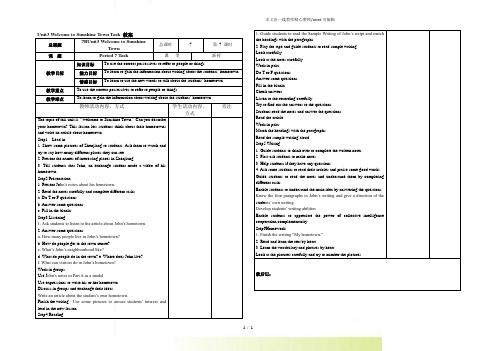
本文由一线教师精心整理/word 可编辑1 / 1总课题7BUnit3 Welcome to SunshineTown总课时 7 第 7 课时 课 题Period 7 Task课 型新授教学目标知识目标To use the correct possessives to refer to people or things能力目标 To learn to gain the information about writing about the students ’ hometown. 情感目标To learn to use the new words to talk about the students ’ hometown.教学重点 To use the correct possessives to refer to people or things教学难点To learn to gain the information about writing about the students ’ hometown.教师活动内容、方式学生活动内容、方式旁注The topic of this unit is “welcome to Sunshine Town ”. Can you describe your hometown? This lesson lets students think about their hometowns and write an article about hometown. Step1 Lead in1. Show some pictures of Zhenjiang to students. Ask them to watch and try to say how many different places they can see.2. Present the names of interesting places in Zhenjiang.3. Tell students that John, an exchange student made a video of his hometown.Step2 Presentation1. Present Jo hn’s notes about his hometown.2. Read the notes carefully and complete different tasks. a. Do T or F questions b. Answer some questions c. Fill in the blanks Step3 Listening1. Ask students to listen to the article about John’s hometown.2. Answer some questionsa. How many people live in John’s hometown?b. How do people get to the town centre?c. What’s John’s neighbourhood like?d. What do people do in the town?e. Where does John live?f. What can visitors do in John’s hometown? Work in groupsUse J ohn’s notes in Part A as a modelUse expressions to write his or her hometown Discuss in groups and exchange their ideasWrite an article about the student’s own hometown.Finish the writing. Use some pictures to arouse students’ interest and lead in the new lesson Step4 Reading1. Guide students to read the Sample Writing of John’s script and match the headings with the paragraphs.2. Play the tape and guide students to read sample writing Look carefullyLook at the notes carefully Work in pairsDo T or F questions Answer some questions Fill in the blanks Check answersListen to the recording carefully.Try to find out the answers to the questions. Students read the notes and answer the questions Read the article. Work in pairs.Match the headings with the paragraphs Read the sample writing aloud. Step5 Writing1. Guide students to think over to complete the written notes.2. First ask students to make notes.3. Help students if they have any questions.4. Ask some students to read their articles and praise some good works. Guide students to read the notes and understand them by completing different tasks.Enable students to understand the main idea by answering the questions. Know the four paragraphs in John’s writing and give a direction of the stude nts’ own writingDevelop students’ writing abilitiesEnable students to appreciate the power of collective intelligence cooperation,complementarity Step6Homework1. Finish the writing “My hometown.”2. Read and learn the text by heart.3. Learn the vocabulary and phrases by heart.Look at the pictures carefully and try to number the pictures教后记:。
七年级英语下册 Unit 3 Welcome to Sunshine Town教案 (新版)牛津版

Unit 3 Welcome to Sunshine TownWelcome to the unit教学目标1.Make suggestions about visiting places and doing activities.2. Use “How much” and “How many” to express questions.重点难点1.To talk about things to do in their hometowns.教学用具Tape- recorder,multimedia教学方法Working in groups.教学内容Comic stripStep 1 Lead-inWatch and answerT: Hello, everyone, today we are going to learn Comic strip & Welcome to the unit of Unit 3. First, who’d like to say something about your hometown?Step 2 Presentation1. Listen and answerT: Listen to the conversation between Eddie and Hobo and answer the questions below.(1) Is there anything left in the fridge?(2) How much money do they have?(3) What does Eddie want to do with the money?【设计意图:通过听对话回答问题,训练学生从对话内容大意到细节的把握。
】2. Act the dialogue out【设计意图:通过表演有趣的漫画,让学生在表演中运用英语,不仅提升了课堂的乐趣,并且训练了学生的语言运用能力。
7B第三单元教案新部编本
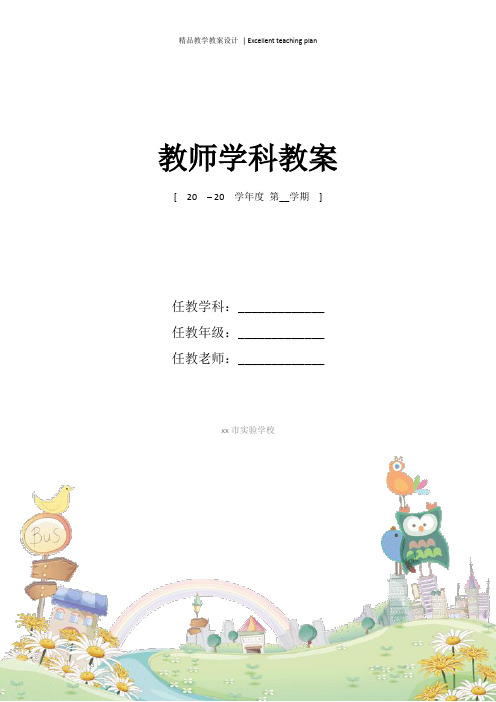
教师学科教案[ 20 – 20 学年度第__学期]任教学科:_____________任教年级:_____________任教老师:_____________xx市实验学校7B Unit 3 Welcome to Sunshine Town (Welcome )第1课时共6课时Ⅰ.Teaching aims1.Words and useful expressions:1) Be able to read and spell correctly 2) Know the usage of them2. Function:1) Be able to introduce the topic of places2) Be able to activate existing vocabulary and identify the meanings of new words related to thetopic3) Be able to guess meaning from pictures4) Be able to talk about visits and means of transport using model sentencesⅡTeaching aidsA multimedia computer7B Unit3 Welcome to Sunshine Town (Welcome ) I’m hungry.How many tins of dog food can we buy with that?None.Sports centre教学反思:7B Unit 3 Welcome to Sunshine Town (Reading)第2 课时共6课时Ⅰ.Teaching aims1.Words and useful expressions:1) Be able to read and spell correctly 2) Know the usage of them2. Function:1) Be able to understand and use the expressions in the text2) Be able to identify specific details.3) Be able to retell the story in their own words ⅡTeaching aidsA multimedia computerⅣ. 板书设计7B Unit 3 Welcome to Sunshine Town (Reading)There are lots of things to do in Sunshine Town.There is less air pollution in Sunshine Town than in other areas of Beijing. Most of us live in buildings like this.They do not have to go far if they need help with their homework. Why don ’t you visit our local theatre with us?教学反思:7B Unit 3 Welcome to Sunshine Town (Grammar)第3 课时 共6课时Ⅰ.Teaching aimsⅠ.Teaching aims1.Words and useful expressions:1) Be able to read and spell correctly 2) Know the usage of them 2. Function:1) Be able to recognize expressions2) Be able to use prepositions of movemen Ⅱ Teaching aidsA multimedia computerⅤ. 板书设计7B Unit 3 Welcome to Sunshine Town (Grammar)Thirty of each will be enough.Fifteen loaves of breadDo these postcards belong to Daniel?They are all over the piace.Our class is planning to hold a welcome party for the exchange students. Ⅵ. 教学反思7B Unit 3 Welcome to Sunshine Town (Integrated skills)第4 课时共6 课时Ⅰ.Teaching aims1.Words and useful expressions:1) Be able to read and spell correctly 2) Know the usage of them2. Function:1) Be able to recognize key expressions2) Be able to use key information given in instructions and identify the specific order of themfrom listening3) Be able to develop intensive listening skills by following instructionsⅡTeaching aidsA multimedia computer7B Unit 2 Welcome to Sunshine Town (Integrated skills)Many moreThere are lots of fun and interesting things to see. What time shall we leave in the morning?Ⅴ. 教学反思7B Unit 3 Welcome to Sunshine Town (study skills)第5 课时共6 课时Ⅰ.Teaching aims 1.To learn stress in sentences.2.To know more about stress in different parts.ⅡTeaching aids Learn to read the words by themselves.Mr Li owns a four-bedroom flat. Mr Li owns a four-bedroom flat.Mr Li owns a four-bedroom flat. Mr Li owns a four-bedroom flat.教学反思:7B Unit 3 Welcome to Sunshine Town ( Task)第6 课时共6 课时Ⅰ.Teaching aims1.Words and useful expressions:1) Be able to read and spell correctly 2) Know the usage of them2. Function:1) Be able to select, organize and present information2) Be able to develop an understanding of the key components3) Be able to express directions and information in the context oⅡTeaching aidsA multimedia computerⅢⅤ7B Unit 3 Welcome to Sunshine Town ( Task)I’m going to show you around my home town.It takes about twenty minutes to get to the nearest town.I like going into town on my bicycle.There is not much pollution in the town.Ⅵ. 教学反思。
- 1、下载文档前请自行甄别文档内容的完整性,平台不提供额外的编辑、内容补充、找答案等附加服务。
- 2、"仅部分预览"的文档,不可在线预览部分如存在完整性等问题,可反馈申请退款(可完整预览的文档不适用该条件!)。
- 3、如文档侵犯您的权益,请联系客服反馈,我们会尽快为您处理(人工客服工作时间:9:00-18:30)。
教学反思
授课时间:年月日
Unit3Welcome to Sunshine Town
章、节
Reading
课时
第2课时
课型
New
教学
目标
1.To master some words and phrases.
underground, air pollution, area, country, lake, building, such, place, like, close, Western, local, theatre, teach
Step FiveActivity
Use Eddie and Hobo’s conversation as a model. Talk about something about you and you partner.
提示:There’s no food in the fridge, go shop, only havetenyuan, only can order a little food.
Step ThreeSum up some phrases
some dog food, go to the supermarket, how much money,
how many tins, buy something with some money, order a pizza,
enjoy Chinese food, take them to the sports centre.
Step Four Explain points
1.There’s no dog food. = There isn’t any dog food.
no= not any / a
e.g: I have no money.=______________________
There is no student in the room. =__________________
Step TwoEntering
1.Eddie often goes to the restaurant with Hobo.He often orders a tin of
dog food. Sometimes he orders a pizza it he hasn’t enough money.
centre.
2.Understand the following sentences:There’s no dog food./How many tins of dog food
can we buy with that?/Maybe we can order a pizza./Let’s take them to the sports centre.
with意为“凭借”,“使用某种工具”。
e.g: We write with our hands.
He bought a kite with his pocket money.
3.Let’s take them to the sports centre.
take sb / sth to some place带某人/某物去某地
2.To master some sentences.
1)There’s less are pollution inSunshineTownthan in other areas ofBeijing.
2)You can choose any food you like inSunshineTown.
e the words and phrases correctly.
重点
难点
1.To revise vocabulary about activities and places in new situations
2.To make suggestions about visiting different places
2.---Do you have any money?
---None. I haven’t any money with me. Maybe Millie has some, but
she is in sports centre now.
Read these new words and phrases.
教学过程
教师复备
Step OneWarming up
1.Would you like to go to the supermarket?
2.Do you have any money with you?
3.How much money do you have?
4.How much does the book cost?
e.g: My parents took me to the hospital when I was ill last week.
Our Chinese teacher will take us to the museum next week.
Don’t take the dog to the cinema.
Unit3Welcome to Sunshine Town
主备人:杨育红备课时间:2013-3-17复备时间:总第课时
章、节
Welcome to the unit
课时
第1课时
课型
New
教学
目标
1.To master the new words and phrases:none, order, badminton,tin, pizza, maybe, sports
“food” is an uncountable noun, we may say,
some food, much food, a lot of food
e.g: There’s a lot of food in the fridge.
2.How many tins of dog food can we buy with that?
3)Why don’t you visit our local theatre with us?
3.Listen, read and repeat the Reading Part.
